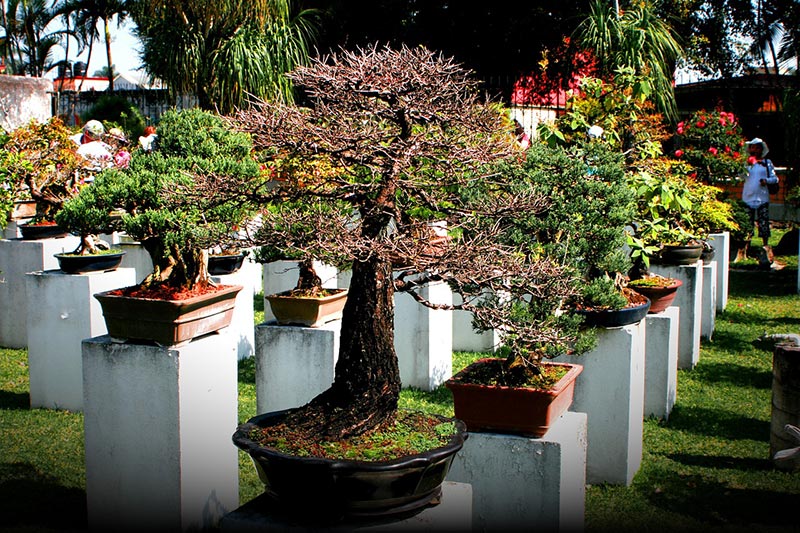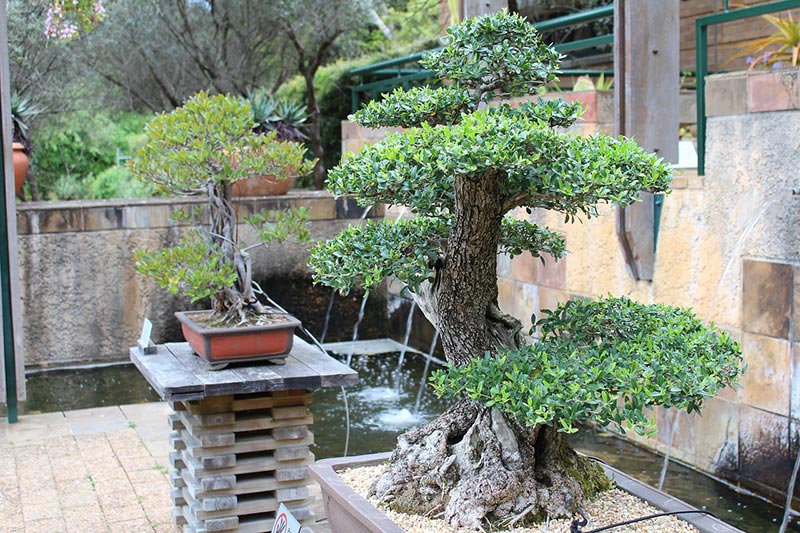How Much Does a Bonsai Tree Cost? (2025 Price Guide)
-
Codee Chessher
- Last updated:

Bonsai trees are an oddity among trees, requiring lots of personalized care. Featured in iconic films like The Karate Kid Part III, bonsai trees are typically very small and considered an art form in Japan. If you are interested in growing a bonsai yourself, you’re probably wondering how much they cost to get started. Let’s check out how much they cost and what you need to know about growing bonsai trees.
What Is the Significance of Bonsai Trees?
Bonsai is a traditional Japanese art where gardeners cultivate and care for miniature trees in shallow pots, though larger bonsai trees exist too. Bonsai are famous for the way pruning shapes the tree to appear more mature. The word “bonsai” actually means “tray planting” in Japanese.
Bonsai was adapted from the Chinese art of penjing, which is very similar in that gardeners shape the trees. However, penjing typically focuses on constructing miniature, natural landscapes, including miniature trees.
A key component of bonsai is choosing dwarf trees, confining them in small containers, and pruning them to resemble larger trees. Caring for bonsai is often considered a lifelong pursuit, with practitioners describing the art as a spiritual or meditative exercise.
Bonsai can be as simple as pruning excessive growth, but practitioners often shape their plants to achieve a natural aesthetic design. For instance, using two bonsai trees, you can shape their branches to make them flow into each other and give the impression of a single tree canopy.

How Much Do Bonsai Trees Cost?
The price of bonsai trees wildly varies based on numerous factors. With that said, you can usually get a very young bonsai for as little as $25 at a nursery. Larger, more mature bonsais that have been shaped into intricate designs usually cost much more. One of the most expensive bonsai trees known is appraised at $1 million!
Bonsai isn’t necessarily an expensive art, but it can be. You can start with a $25 bonsai tree and a cheap pot, and if you enjoy the art, you can spend countless hundreds or thousands of dollars buying new trees, pots, and fertilizer.
Keep in mind that smaller trees may take up to 5 years to mature. Because of this, you will likely have to wait for a few years before you start pruning your tree. If you want to opt for a larger tree that is further along, you can expect one to cost a minimum of $100.
Factors That Impact Bonsai Tree Costs
Bonsai trees are very difficult to appraise because numerous variables affect their price. Let’s check out some of them below and how they affect a bonsai tree’s price.
- Species: Many species are suitable for bonsai, and some are more expensive than others. Miniature weeping willows or jacarandas are cheaper, while junipers are considered the most expensive.
- Size: Established bonsais cost a lot more than a young, unshaped bonsai. Because of the effort required to train and prune large trees, they will cost more.
- Growth Difficulty: Some species of bonsai trees are harder to grow and train than others, which will be reflected in their respective prices.
- Location: Established trees that are ill-suited to your climate are harder to care for, so they will cost more.
- History: Many trees are cared for and passed down through generations, which adds material and sentimental value. The most famous bonsai is the Atomic Tree, which survived the Hiroshima bombing in 1945.
- Appearance: Many bonsai practitioners spend lots of time creating elaborate artistic effects with their trees, and those will cost much more than a young tree.

What Bonsai Tree Is the Easiest to Grow?
Bonsai trees can be intimidating to grow and care for, but not all of them are difficult to care for. Some bonsai species have gained a reputation for being beginner friendly, and it may be worth starting out with one of those to get a feel for how bonsai works. Let’s check out a few of those below.
- Chinese Elm: The go-to beginner bonsai tree. Young trees are usually affordable.
- Ficus: The best beginner choice if you plan to keep your bonsai tree indoors.
- Juniper: The classic bonsai most people think of. Juniper bonsai trees must live outdoors and can live for a very long time.
- Cotoneaster: A great choice if you prefer to see quick results. Cotoneaster trees respond very well to pruning efforts.
How Often to Trim and Prune Bonsai Trees
Trimming bonsai trees helps keep their small size and focus the tree’s energy toward growing in certain ways. Learning the right way to trim your bonsai takes lots of practice and observation, but there are some core ideas you should keep in mind.
By cutting wild or unshaped growth, you can encourage the tree to grow in certain shapes. The tops of trees, in particular, need regular maintenance trimming to get the plant to focus on core or branch growth. Is your tree starting to become unruly or grow in a weird direction? Trim the extra growth to get the tree back in shape.
Cutting young leaves and branches also helps expose lower leaves to air and sunlight, which further encourages growth in a targeted way. Cutting buds helps foliage grow thicker and denser, which regulates the bonsai tree’s shape.
From spring to late summer, outdoor bonsai trees should be trimmed to control the tree’s shape and focus on its growth. Indoor trees are less picky and can be trimmed periodically throughout the year.
Structural pruning is very different—you remove entire healthy branches to train the tree to grow in certain directions. This type of trimming is typically done in the spring, and wires can be wrapped around certain branches to slow their growth and help maintain the tree’s size. The wires have to be removed after a time or else the tree will grow into them and become scarred.

Additional Costs to Anticipate
Bonsai can be as cheap or expensive as you want, but two important factors are the pot and fertilizer.
Expensive, ornate pots with carvings or decorations can cost hundreds of dollars, if not more. Some bonsai starter kits may include a mini-Buddha, flowing water decorations, or other elaborate ornamentation. However, pricy pots are solely for aesthetic value and don’t affect the growth of the tree.
Fertilizer is an entirely different ballgame. Bonsai trees usually need a nitrogen-rich fertilizer to encourage dense foliage, but potassium and phosphorus are key nutrients that enhance a tree’s health and growth. Using a nitrogen-rich fertilizer can help a tree with sparse growth, while healthy trees do well with a balanced fertilizer.
Conclusion
Bonsai trees can get quite expensive if you want an established tree with an elaborate design, while young, unshaped trees can be bought as cheaply as $25. Learning how to trim a bonsai tree and shape it is a personal pursuit, but it doesn’t require a lot of money to grow a beautiful tree.
Featured Image Credit: DuyCuong1080, Pixabay
Contents
